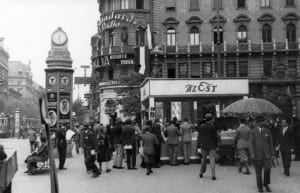Chicago of the Balkans: Budapest in Hungarian literature 1900-1939
By Sarah J Young, on 27 June 2013
From the golden age of Hungarian Jewish culture to inter-war anti-semitism, Budapest is constantly being rewritten, finds Gwen Jones.
Writing in 1910, a good decade before Al Capone and associates attained international notoriety, the Hungarian critic and arts patron Lajos Hatvany (1880-1961) introduced an imaginary Western European reader to the latest developments in his country’s culture and history. Tracing Hungary’s elevation following the 1867 Compromise with Austria, from ‘a rudimentary agricultural people to a higher rank’, into the era of economic growth and progress, he suggested that the country was not merely Europeanizing, it was Americanizing: ‘Budapest will become the Chicago of the Balkans’.
My book takes its title from Hatvany’s ironic remark, and discusses the ways in which Hungarian intellectuals viewed and wrote about their capital city from the turn of the twentieth century until the outbreak of World War Two. Referring to the speed with which Budapest grew in the last quarter of the nineteenth century, and contrasting this with a dusty ‘Balkan’ backwardness on the periphery, Hatvany placed the Hungarian capital within an absurd contradiction. In this, he was far from alone.
While compiling the book’s index, which was by far the most entertaining part of the entire writing process, I began by listing references to ‘Budapest is Hungarian’, and then for ‘Budapest is not Hungarian’. Next, I compiled various images writers had used to describe the city over this forty-year period. Budapest had been compared to, among other things, Babel, Babylon and Sodom. It was a ‘New Jerusalem’ built by Jews, and ‘Judapest’, the latter description attributed to Karl Lueger, who was mayor of Vienna from 1897 to 1910. Budapest was the Hungarian Paris, a muse, a parvenu, a Potemkinopolis, a whore and a volcano. Moreover, the Buda side was stuffy and conservative, much like an elderly uncle, while Pest, the centre of commerce, journalism and cabaret, was a cocotte, a fashionable prostitute. In the words of Rezső Seress’s popular interwar chanson, Hiába van palotád Budán, ‘No point your having a villa in Buda, it’s Pest where you go for fun’. (more…)
 Close
Close


